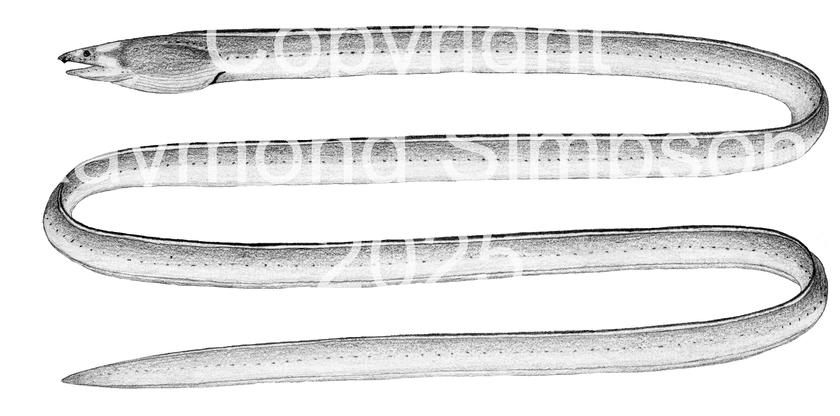
Common Name
Rope Eel
Year Described
McCosker & Böhlke, 1984
Identification
Vertebrae: 176-186
Body elongate. Cylindrical anteriorly in cross-section but compressed posteriorly. Trunk much longer than tail. Snout pointed laterally, conical dorsally, and overhangs mouth. Underside of snout with a toothed median groove reaching anterior nostrils. Eye small and around middle of jaw. Anterior nostril a simple flush hole (not tubular) with connecting groove. Posterior nostril opens under eye as a small slit. Jaw teeth small and uniserial. Intermaxillary teeth (3) present. Vomerine teeth in 2-3 biserial rows and a single row of 3-4 teeth. Gill openings crescent-shaped, low on body and converging anteriorly. Gill pouch and body distinctly grooved. Dorsal fin origin well before gill openings, low in height, and ending before tail tip. Anal fin present. Pectoral and caudal fins absent. Tail tip hard and pointed. Lateral line complete (170-179 pores). One temporal, 1 interorbital, 5 mandibular, and 2 preopercular pores.
Color
Body yellowish-cream with dark brown dorsal half. Body ridges dark and furrows pale. Head dark dorsally with pale blotches around and behind the eye. Dorsal and anal fins pale.
Size
Maximum size to 66.9cm TL.
Habitat
Shallow waters on sandy bottoms (7-45m). Occurs shallower than relatives in genus.
Range
Known from the western and southern Gulf of Mexico, off Colombia, and Puerto Rico.
References
McCosker, J. E., & J. E. Böhlke. 1984. A review of the snake eel genera Gordiichthys and Ethadophis, with descriptions of new species and comments on related Atlantic bascanichthyins (Pisces: Ophichthidae). Proceedings of the Academy of Natural Sciences of Philadelphia, 32-44.
Other Notes
The three very slender Gordiichthys can be best separated by lateral pore and vertebral counts (G. ergodes also has tubular nostrils). The fourth species, G. randalli, is less slender and has biserial vomerine teeth.